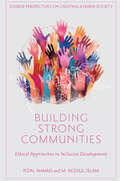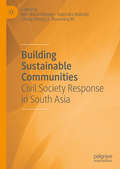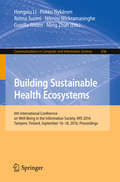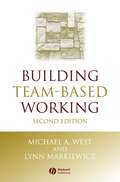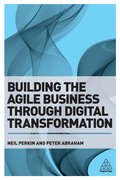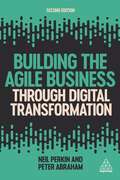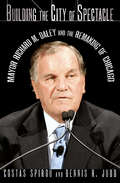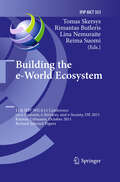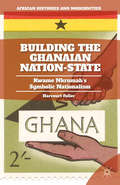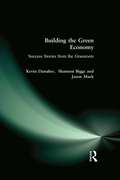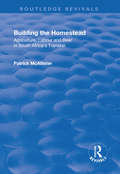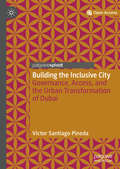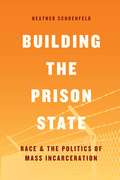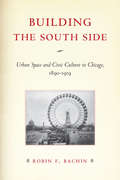- Table View
- List View
Building Strong Communities: Ethical Approaches to Inclusive Development (Diverse Perspectives on Creating a Fairer Society)
by Ifzal Ahmad M. Rezaul IslamExploring ethical approaches to inclusive development, Building Strong Communities navigates challenges and strategies, empowering readers to foster resilient, equitable communities in the ever evolving 21st century. Encompassing a wealth of illustrative examples and valuable experiences from different countries around the world, including Canada, Brazil, Sweden, Kenya, China, Australia, Antarctica, India, and more, chapters tackle the mounting necessity for sustainable and equitable development practice. Featuring tools and insights that hold the potential to guide policymakers, practitioners, and scholars alike in the pursuit of nurturing resilient and thriving communities, authors Ifzal Ahmad and M. Rezaul Islam focus on the importance of ethics and inclusivity, offering an interdisciplinary approach, practical frameworks, and impact-driven recommendations for creating thriving communities on a global scale. Illuminating the dynamic interplay between theory and practice, the inclusion of global perspectives showcases the diverse contexts and unique challenges faced by communities around the world, enriching an understanding of community development’s complex landscape. Transcending disciplinary silos and fostering a more comprehensive understanding of community development, Building Strong Communities empowers readers to draw upon multiple perspectives and tools to create meaningful and sustainable change in diverse community contexts and develop holistic solutions that address the interrelated social, economic, environmental, and cultural aspects of community well-being.
Building Strong Communities: Ethical Approaches to Inclusive Development (Diverse Perspectives on Creating a Fairer Society)
by Ifzal Ahmad M. Rezaul IslamExploring ethical approaches to inclusive development, Building Strong Communities navigates challenges and strategies, empowering readers to foster resilient, equitable communities in the ever evolving 21st century. Encompassing a wealth of illustrative examples and valuable experiences from different countries around the world, including Canada, Brazil, Sweden, Kenya, China, Australia, Antarctica, India, and more, chapters tackle the mounting necessity for sustainable and equitable development practice. Featuring tools and insights that hold the potential to guide policymakers, practitioners, and scholars alike in the pursuit of nurturing resilient and thriving communities, authors Ifzal Ahmad and M. Rezaul Islam focus on the importance of ethics and inclusivity, offering an interdisciplinary approach, practical frameworks, and impact-driven recommendations for creating thriving communities on a global scale. Illuminating the dynamic interplay between theory and practice, the inclusion of global perspectives showcases the diverse contexts and unique challenges faced by communities around the world, enriching an understanding of community development’s complex landscape. Transcending disciplinary silos and fostering a more comprehensive understanding of community development, Building Strong Communities empowers readers to draw upon multiple perspectives and tools to create meaningful and sustainable change in diverse community contexts and develop holistic solutions that address the interrelated social, economic, environmental, and cultural aspects of community well-being.
Building Sustainable Communities: Civil Society Response in South Asia
by Rajendra Baikady Md. Nurul Momen Cheng Sheng Li M. BasavarajThe book aims to explore South Asian third sector – the nonprofit organizations as provider of social services. The book defines social welfare and describe its relationship to social service programmes and individual well-being; understands the social policy development from the problem identification to policy implementation; describes the range of organization of social service agencies that are responsible for providing social welfare programmes; explores the various roles that professional and non- professional helpers provide in the delivery of social welfare and their influence in promoting change in policy development; and understands the umbrella concept of Child welfare, welfare of people with disability and elderly welfare in welfare policy.
Building Sustainable Health Ecosystems: 6th International Conference on Well-Being in the Information Society, WIS 2016, Tampere, Finland, September 16-18, 2016, Proceedings (Communications in Computer and Information Science #636)
by Hongxiu Li Pirkko Nykänen Reima Suomi Nilmini Wickramasinghe Gunilla Widén Ming ZhanThis book constitutes the refereed proceedings of the 6th International Conference on Well-Being in the Information Society, WIS 2016, held in Tampere, Finland, in September 2016. The 21 revised full papers presented were carefully reviewed and selected from 42 submissions. With the core topic "Building Sustainable Health Ecosystems" WIS 2016 focused on innovations and fresh ideas in the cross-section of urban living, information society and health as understood in a wide sense. The papers presented in this volume are organized along the following seven broad topics: 1. Macro level considerations of e-health and welfare, 2.Welfare issues of children, youth, young elderly and seniors, 3. Analytics issues of eHealth and welfare, 4. National/regional initiatives in eHealth and welfare, and 5. Specific topics of eHealth. The papers in these topics span qualitative and quantitative analysis, empirical surveys, case studies as well as conceptual work.
Building Team-Based Working: A Practical Guide to Organizational Transformation (One Stop Training)
by Michael A. West Lynn MarkiewiczThis book gives managers and consultants practical guidance on how to build organizations that are structured around effective teamworking. This text focuses on how to build organizations that are structured around teams. Ideal for managers or consultants who are introducing team-based working into organizations. Examines the psychological and social processes that can facilitate or obstruct successful teamwork. Each chapter contains aims, activities, support materials and tools. Support materials can also be downloaded from an accompanying website. Based on evidence gathered by the authors over 20 years of practical management experience, research in organizations, and consultancy.
Building the Agile Business through Digital Transformation
by Neil Perkin Peter AbrahamBuilding the Agile Business through Digital Transformation is an in-depth look at transforming businesses so they are fit for purpose in a digitally enabled world. It is a guide for all those needing to better understand, implement and lead digital transformation in the workplace. It sets aside traditional thinking and outdated strategies to explain what steps need to be taken for an organization to become truly agile. It addresses how to build organizational velocity and establish iterative working, remove unnecessary process, embed innovation, map strategy to motivation and develop talent to succeed. Building the Agile Business through Digital Transformation provides guidance on how to set the pace and frequency for change and shows how to break old habits and reform the behaviours of a workforce to embed digital transformation, achieve organizational agility and ensure high performance. Full of practical advice, examples and real-life insights from organizational development professionals at the leading edge of digital transformation, this book is an essential guide to building an agile business.
Building the Agile Business through Digital Transformation
by Neil Perkin Peter AbrahamBuilding the Agile Business through Digital Transformation is an in-depth look at transforming businesses so they are fit for purpose in a digitally enabled world. It is a guide for all those needing to better understand, implement and lead digital transformation in the workplace. It sets aside traditional thinking and outdated strategies to explain what steps need to be taken for an organization to become truly agile. It addresses how to build organizational velocity and establish iterative working, remove unnecessary process, embed innovation, map strategy to motivation and develop talent to succeed. Building the Agile Business through Digital Transformation provides guidance on how to set the pace and frequency for change and shows how to break old habits and reform the behaviours of a workforce to embed digital transformation, achieve organizational agility and ensure high performance. Full of practical advice, examples and real-life insights from organizational development professionals at the leading edge of digital transformation, this book is an essential guide to building an agile business.
Building the Agile Business through Digital Transformation
by Neil Perkin Peter AbrahamHow can businesses transform to achieve competitive advantage in a digital-enabled world? How can managers and leaders create a culture that supports lasting change through these transformations?Building the Agile Business through Digital Transformation is an in-depth guide for all those needing to better understand, implement and lead digital transformation in the workplace. It sets aside traditional thinking and outdated strategies to explain what steps need to be taken for an organization to become truly agile, embed innovation and develop talent to succeed.This majorly revised second edition of Building the Agile Business through Digital Transformation contains new material on the culture and mindset challenges of shifting at scale from linear to agile working, and using data effectively in organizational decision-making. Full of practical advice, examples and real-life insights from organizations at the leading edge of digital transformation including AirBnb, Amazon and Google, this book is an essential guide to driving success by becoming an agile and digital native business.
Building the City of Spectacle: Mayor Richard M. Daley and the Remaking of Chicago
by Costas Spirou Dennis R. JuddBy the time he left office on May 16, 2011, Mayor Richard M. Daley had served six terms and more than twenty-two years at the helm of Chicago’s City Hall, making him the longest serving mayor in the city’s history. Richard M. Daley was the son of the legendary machine boss, Mayor Richard J. Daley, who had presided over the city during the post–World War II urban crisis. Richard M. Daley led a period of economic restructuring after that difficult era by building a vibrant tourist economy. Costas Spirou and Dennis R. Judd focus on Richard M. Daley’s role in transforming Chicago’s economy and urban culture.The construction of the "city of spectacle" required that Daley deploy leadership and vision to remake Chicago’s image and physical infrastructure. He gained the resources and political power necessary for supporting an aggressive program of construction that focused on signature projects along the city’s lakefront, including especially Millennium Park, Navy Pier, the Museum Campus, Northerly Island, Soldier Field, and two major expansions of McCormick Place, the city’s convention center. During this period Daley also presided over major residential construction in the Loop and in the surrounding neighborhoods, devoted millions of dollars to beautification efforts across the city, and increased the number of summer festivals and events across Grant Park. As a result of all these initiatives, the number of tourists visiting Chicago skyrocketed during the Daley years.Daley has been harshly criticized in some quarters for building a tourist-oriented economy and infrastructure at the expense of other priorities. Daley left his successor, Rahm Emanuel, with serious issues involving a long-standing pattern of police malfeasance, underfunded and uneven schools, inadequate housing opportunities, and intractable budgetary crises. Nevertheless, Spirou and Judd conclude, because Daley helped transform Chicago into a leading global city with an exceptional urban culture, he also left a positive imprint on the city that will endure for decades to come.
Building the e-World Ecosystem: 11th IFIP WG 6.11 Conference on e-Business, e-Services, and e-Society, I3E 2011, Kaunas, Lithuania, October 12-14, 2011, Revised Selected Papers (IFIP Advances in Information and Communication Technology #353)
by Tomas Skersys Rimantas Butleris Lina Nemuraite Reima SuomiThis book constitutes the thoroughly refereed post-conference proceedings of the 11th IFIP WG 6.11 Conference on e-Business, e-Services and e-Society, I3E 2011, held in Kaunas, Lithuania, in October 2011. The 25 revised papers presented were carefully reviewed and selected from numerous submissions. They are organized in the following topical sections: e-government and e-governance, e-services, digital goods and products, e-business process modeling and re-engineering, innovative e-business models and implementation, e-health and e-education, and innovative e-business models.
Building the Ghanaian Nation-State: Kwame Nkrumah’s Symbolic Nationalism (African Histories and Modernities)
by H. FullerGhana has always held a position of primacy in the African political and historical imagination, due in no small part to the indelible impression left president Kwame Nkrumah. This study examines the symbolic strategies he used to construct the Ghanaian state through currency, stamps, museums, flags, and other public icons.
Building the Green Economy: Success Stories from the Grassroots
by Kevin Danaher Shannon Biggs Jason MarkAfter centuries of economic activity based on extraction, exploitation, and depletion, we now face undeniable environmental threats. New business models that save or restore natural resources are critical. But how can we translate that insight into more sustainable practices?Building the Green Economy shows how community groups, families, and individual citizens have taken action to protect their food and water, clean up their neighborhoods, and strengthen their local economies. Their unlikely victories—over polluters, unresponsive bureaucracies, and unexamined routines—dramatize the opportunities and challenges facing the local green economy movement.Drawing on their extensive experience at Global Exchange and elsewhere, the authors also:Lay out strategies for a more successful green movementDescribe how communities have protected their victories from legal and political challengesProvide key resources for local activistsInclude conversations with Rocky Anderson, Lois Gibbs, Anuradha Mittal, David Morris, Michael Shuman, and other activists and leaders.
Building the Green Economy: Success Stories from the Grassroots
by Kevin Danaher Shannon Biggs Jason MarkAfter centuries of economic activity based on extraction, exploitation, and depletion, we now face undeniable environmental threats. New business models that save or restore natural resources are critical. But how can we translate that insight into more sustainable practices?Building the Green Economy shows how community groups, families, and individual citizens have taken action to protect their food and water, clean up their neighborhoods, and strengthen their local economies. Their unlikely victories—over polluters, unresponsive bureaucracies, and unexamined routines—dramatize the opportunities and challenges facing the local green economy movement.Drawing on their extensive experience at Global Exchange and elsewhere, the authors also:Lay out strategies for a more successful green movementDescribe how communities have protected their victories from legal and political challengesProvide key resources for local activistsInclude conversations with Rocky Anderson, Lois Gibbs, Anuradha Mittal, David Morris, Michael Shuman, and other activists and leaders.
Building the Homestead: Agriculture, Labour and Beer in South Africa's Transkei
by P. McAllisterThis title was first published in 2001. "This is also a study of rural Xhosa identity and community, and its survival in the face of the overwhelming odds stacked against it by colonialism and apartheid. The maintenance of homestead production can be properly understood only if this wider context is taken into consideration. The analysis is thus directly relevant to current debates about agrarian change, land reform and economic development in South Africa's communal areas, since it shows how some rural Xhosa are able to maintain a sense of community and identity, and of how they are able to harness the socio-cultural resources at their disposal to engage in productive activity, with some success."--BOOK JACKET.
Building the Homestead: Agriculture, Labour and Beer in South Africa's Transkei
by P. McAllisterThis title was first published in 2001. "This is also a study of rural Xhosa identity and community, and its survival in the face of the overwhelming odds stacked against it by colonialism and apartheid. The maintenance of homestead production can be properly understood only if this wider context is taken into consideration. The analysis is thus directly relevant to current debates about agrarian change, land reform and economic development in South Africa's communal areas, since it shows how some rural Xhosa are able to maintain a sense of community and identity, and of how they are able to harness the socio-cultural resources at their disposal to engage in productive activity, with some success."--BOOK JACKET.
Building the Inclusive City: Governance, Access, and the Urban Transformation of Dubai
by Victor Santiago PinedaThis Open Access book is an anthropological urban study of the Emirate of Dubai, its institutions, and their evolution. It provides a contemporary history of disability in city planning from a non-Western perspective and explores the cultural context for its positioning. Three insights inform the author’s approach. First, disability research, much like other urban or social issues, must be situated in a particular place. Second, access and inclusion forms a key part of both local and global planning issues. Third, a 21st century planning education should take access and inclusion into consideration by applying a disability lens to the empirical, methodological, and theoretical advances of the field. By bridging theory and practice, this book provides new insights on inclusive city planning and comparative urban theory. This book should be read as part of a larger struggle to define and assert access; it’s a story of how equity and justice are central themes in building the cities of the future and of today.
Building the Prison State: Race and the Politics of Mass Incarceration (Chicago Series in Law and Society)
by Heather SchoenfeldThe United States incarcerates more people per capita than any other industrialized nation in the world—about 1 in 100 adults, or more than 2 million people—while national spending on prisons has catapulted 400 percent. Given the vast racial disparities in incarceration, the prison system also reinforces race and class divisions. How and why did we become the world’s leading jailer? And what can we, as a society, do about it? Reframing the story of mass incarceration, Heather Schoenfeld illustrates how the unfinished task of full equality for African Americans led to a series of policy choices that expanded the government’s power to punish, even as they were designed to protect individuals from arbitrary state violence. Examining civil rights protests, prison condition lawsuits, sentencing reforms, the War on Drugs, and the rise of conservative Tea Party politics, Schoenfeld explains why politicians veered from skepticism of prisons to an embrace of incarceration as the appropriate response to crime. To reduce the number of people behind bars, Schoenfeld argues that we must transform the political incentives for imprisonment and develop a new ideological basis for punishment.
Building the Prison State: Race and the Politics of Mass Incarceration (Chicago Series in Law and Society)
by Heather SchoenfeldThe United States incarcerates more people per capita than any other industrialized nation in the world—about 1 in 100 adults, or more than 2 million people—while national spending on prisons has catapulted 400 percent. Given the vast racial disparities in incarceration, the prison system also reinforces race and class divisions. How and why did we become the world’s leading jailer? And what can we, as a society, do about it? Reframing the story of mass incarceration, Heather Schoenfeld illustrates how the unfinished task of full equality for African Americans led to a series of policy choices that expanded the government’s power to punish, even as they were designed to protect individuals from arbitrary state violence. Examining civil rights protests, prison condition lawsuits, sentencing reforms, the War on Drugs, and the rise of conservative Tea Party politics, Schoenfeld explains why politicians veered from skepticism of prisons to an embrace of incarceration as the appropriate response to crime. To reduce the number of people behind bars, Schoenfeld argues that we must transform the political incentives for imprisonment and develop a new ideological basis for punishment.
Building the Prison State: Race and the Politics of Mass Incarceration (Chicago Series in Law and Society)
by Heather SchoenfeldThe United States incarcerates more people per capita than any other industrialized nation in the world—about 1 in 100 adults, or more than 2 million people—while national spending on prisons has catapulted 400 percent. Given the vast racial disparities in incarceration, the prison system also reinforces race and class divisions. How and why did we become the world’s leading jailer? And what can we, as a society, do about it? Reframing the story of mass incarceration, Heather Schoenfeld illustrates how the unfinished task of full equality for African Americans led to a series of policy choices that expanded the government’s power to punish, even as they were designed to protect individuals from arbitrary state violence. Examining civil rights protests, prison condition lawsuits, sentencing reforms, the War on Drugs, and the rise of conservative Tea Party politics, Schoenfeld explains why politicians veered from skepticism of prisons to an embrace of incarceration as the appropriate response to crime. To reduce the number of people behind bars, Schoenfeld argues that we must transform the political incentives for imprisonment and develop a new ideological basis for punishment.
Building the Prison State: Race and the Politics of Mass Incarceration (Chicago Series in Law and Society)
by Heather SchoenfeldThe United States incarcerates more people per capita than any other industrialized nation in the world—about 1 in 100 adults, or more than 2 million people—while national spending on prisons has catapulted 400 percent. Given the vast racial disparities in incarceration, the prison system also reinforces race and class divisions. How and why did we become the world’s leading jailer? And what can we, as a society, do about it? Reframing the story of mass incarceration, Heather Schoenfeld illustrates how the unfinished task of full equality for African Americans led to a series of policy choices that expanded the government’s power to punish, even as they were designed to protect individuals from arbitrary state violence. Examining civil rights protests, prison condition lawsuits, sentencing reforms, the War on Drugs, and the rise of conservative Tea Party politics, Schoenfeld explains why politicians veered from skepticism of prisons to an embrace of incarceration as the appropriate response to crime. To reduce the number of people behind bars, Schoenfeld argues that we must transform the political incentives for imprisonment and develop a new ideological basis for punishment.
Building the Prison State: Race and the Politics of Mass Incarceration (Chicago Series in Law and Society)
by Heather SchoenfeldThe United States incarcerates more people per capita than any other industrialized nation in the world—about 1 in 100 adults, or more than 2 million people—while national spending on prisons has catapulted 400 percent. Given the vast racial disparities in incarceration, the prison system also reinforces race and class divisions. How and why did we become the world’s leading jailer? And what can we, as a society, do about it? Reframing the story of mass incarceration, Heather Schoenfeld illustrates how the unfinished task of full equality for African Americans led to a series of policy choices that expanded the government’s power to punish, even as they were designed to protect individuals from arbitrary state violence. Examining civil rights protests, prison condition lawsuits, sentencing reforms, the War on Drugs, and the rise of conservative Tea Party politics, Schoenfeld explains why politicians veered from skepticism of prisons to an embrace of incarceration as the appropriate response to crime. To reduce the number of people behind bars, Schoenfeld argues that we must transform the political incentives for imprisonment and develop a new ideological basis for punishment.
Building the Prison State: Race and the Politics of Mass Incarceration (Chicago Series in Law and Society)
by Heather SchoenfeldThe United States incarcerates more people per capita than any other industrialized nation in the world—about 1 in 100 adults, or more than 2 million people—while national spending on prisons has catapulted 400 percent. Given the vast racial disparities in incarceration, the prison system also reinforces race and class divisions. How and why did we become the world’s leading jailer? And what can we, as a society, do about it? Reframing the story of mass incarceration, Heather Schoenfeld illustrates how the unfinished task of full equality for African Americans led to a series of policy choices that expanded the government’s power to punish, even as they were designed to protect individuals from arbitrary state violence. Examining civil rights protests, prison condition lawsuits, sentencing reforms, the War on Drugs, and the rise of conservative Tea Party politics, Schoenfeld explains why politicians veered from skepticism of prisons to an embrace of incarceration as the appropriate response to crime. To reduce the number of people behind bars, Schoenfeld argues that we must transform the political incentives for imprisonment and develop a new ideological basis for punishment.
Building the South Side: Urban Space and Civic Culture in Chicago, 1890-1919 (Historical Studies of Urban America)
by Robin F. BachinBuilding the South Side explores the struggle for influence that dominated the planning and development of Chicago's South Side during the Progressive Era. Robin F. Bachin examines the early days of the University of Chicago, Chicago’s public parks, Comiskey Park, and the Black Belt to consider how community leaders looked to the physical design of the city to shape its culture and promote civic interaction. Bachin highlights how the creation of a local terrain of civic culture was a contested process, with the battle for cultural authority transforming urban politics and blurring the line between private and public space. In the process, universities, parks and playgrounds, and commercial entertainment districts emerged as alternative arenas of civic engagement. “Bachin incisively charts the development of key urban institutions and landscapes that helped constitute the messy vitality of Chicago’s late nineteenth- and early twentieth-century public realm.”—Daniel Bluestone, Journal of American History "This is an ambitious book filled with important insights about issues of public space and its use by urban residents. . . . It is thoughtful, very well written, and should be read and appreciated by anyone interested in Chicago or cities generally. It is also a gentle reminder that people are as important as structures and spaces in trying to understand urban development." —Maureen A. Flanagan, American Historical Review
Building the South Side: Urban Space and Civic Culture in Chicago, 1890-1919 (Historical Studies of Urban America)
by Robin F. BachinBuilding the South Side explores the struggle for influence that dominated the planning and development of Chicago's South Side during the Progressive Era. Robin F. Bachin examines the early days of the University of Chicago, Chicago’s public parks, Comiskey Park, and the Black Belt to consider how community leaders looked to the physical design of the city to shape its culture and promote civic interaction. Bachin highlights how the creation of a local terrain of civic culture was a contested process, with the battle for cultural authority transforming urban politics and blurring the line between private and public space. In the process, universities, parks and playgrounds, and commercial entertainment districts emerged as alternative arenas of civic engagement. “Bachin incisively charts the development of key urban institutions and landscapes that helped constitute the messy vitality of Chicago’s late nineteenth- and early twentieth-century public realm.”—Daniel Bluestone, Journal of American History "This is an ambitious book filled with important insights about issues of public space and its use by urban residents. . . . It is thoughtful, very well written, and should be read and appreciated by anyone interested in Chicago or cities generally. It is also a gentle reminder that people are as important as structures and spaces in trying to understand urban development." —Maureen A. Flanagan, American Historical Review
Building the South Side: Urban Space and Civic Culture in Chicago, 1890-1919 (Historical Studies of Urban America)
by Robin F. BachinBuilding the South Side explores the struggle for influence that dominated the planning and development of Chicago's South Side during the Progressive Era. Robin F. Bachin examines the early days of the University of Chicago, Chicago’s public parks, Comiskey Park, and the Black Belt to consider how community leaders looked to the physical design of the city to shape its culture and promote civic interaction. Bachin highlights how the creation of a local terrain of civic culture was a contested process, with the battle for cultural authority transforming urban politics and blurring the line between private and public space. In the process, universities, parks and playgrounds, and commercial entertainment districts emerged as alternative arenas of civic engagement. “Bachin incisively charts the development of key urban institutions and landscapes that helped constitute the messy vitality of Chicago’s late nineteenth- and early twentieth-century public realm.”—Daniel Bluestone, Journal of American History "This is an ambitious book filled with important insights about issues of public space and its use by urban residents. . . . It is thoughtful, very well written, and should be read and appreciated by anyone interested in Chicago or cities generally. It is also a gentle reminder that people are as important as structures and spaces in trying to understand urban development." —Maureen A. Flanagan, American Historical Review
